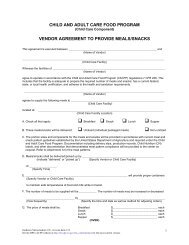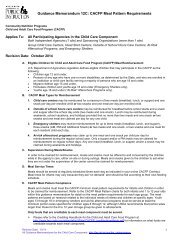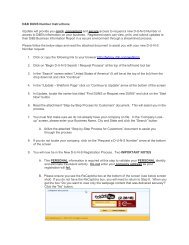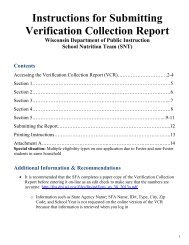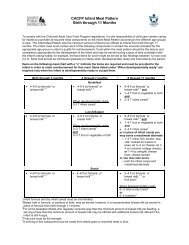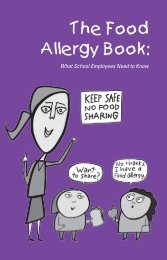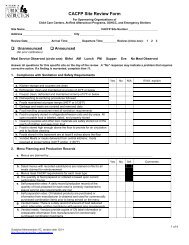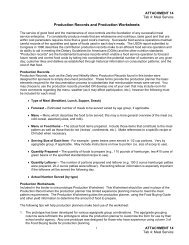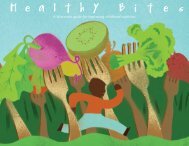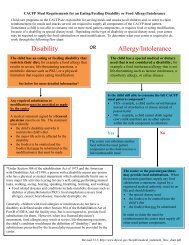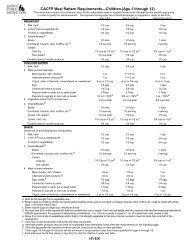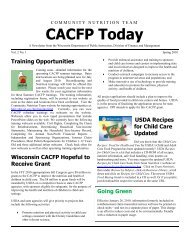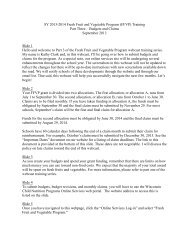plants (nuts, olives, avocadoes) or fish and are liquid at room temperature. Oilsare a good source of healthy unsaturated fats and are generally cholesterol-free;compared to solid fats, oils are a healthier option. For more information onsolid fats, see: http://www.choosemyplate.gov/weight-managementcalories/calories/solid-fats.htmlAdded sugarsSugars are found naturally in fruits, milk, yogurt, and cheese. However, themajority of sugars in typical American diets are “added sugars.” Added sugarsare often called “empty calories” because they add calories to the diet withoutoffering nutrients. The extra calories from added sugars make it harder forchildren to grow at a healthy weight, and may contribute to weight gain; sugaralso increases the risk for dental cavities. Sodas, fruit drinks, cakes, pies,cookies, dairy desserts, and candy are the major sources of added sugars forchildren and adolescents 2 to 18 years old. Check ingredient lists for addedsugars, including: high fructose corn syrup, white sugar, brown sugar, honey,molasses, corn syrup solids, raw sugar, malt syrup, maple syrup, pancakesyrup, or other ingredients ending in “-ose,” such as maltose or fructose.Choose foods that do not list added sugars among the first three ingredients inthe ingredient list. For more information on added sugars, see:http://www.choosemyplate.gov/weight-management-calories/calories/addedsugars.htmlBuild a Healthy Plate with FruitsMost children 4 years and older do not consume enough fruit. You can help byoffering different fruits on your menu. Offering a variety of fruits during the weekcan: Teach healthy eating habits children will use for life. Add color, texture, and flavor to children’s plates. Give children the vitamins and minerals they need to grow and play. Promote proper digestion, help children feel full, and maintain a healthyweight by providing dietary fiber.What type of fruits should I offer?‣ Fresh, frozen, canned, and dried fruits are all great choices. Introduce kidsto the whole rainbow of fruit choices – each fruit has its own unique flavorand nutrients. Providing different choices each day helps children get thenutrition they need.‣ Limit fruit juice. While 100% fruit juice can be part of a healthy diet, itdoes not contain the dietary fiber found in other forms of fruit.‣ Include good sources of potassium, such as bananas, dried plums,cantaloupe, honeydew melon, nectarines, raspberries, and orange juice.Potassium can help children maintain a healthy blood pressure.How can I serve fruits and juices with no added sugars?It is easy for children to get too many added sugars from foods and beverages. Theextra calories from these added sugars can make children feel full before they’vehad a chance to get the nutrients they need from other foods. Extra calories fromadded sugars also make it harder for children to maintain a healthy weight. Since26
fruits are naturally sweet, it can be easy to get children to eat them without addingsweeteners like sugar, corn syrup, and honey. Here are a few tips:‣ Serve fresh fruit more often than fruit-based desserts, such as fruit pies,cobblers, and crisps.‣ Purchase fruit canned in water or 100% fruit juice instead of syrup. Offerunsweetened applesauce and try sprinkling ground cinnamon on top.‣ Purchase frozen fruit that does not contain added sugars.‣ Choose 100% fruit juice instead of fruit-flavored drinks or soda, includingcola, lemon lime, root beer, or orange soda.‣ Offer raisins or other unsweetened dried fruit instead of chewy fruit snacksor strips, fruit drops, candy, or sweets. Since it is easy to eat a lot of driedfruit in a short time, it is best to serve unsweetened dried fruit in a ¼ cupserving. Eating ¼ cup of dried fruit is like eating ½ cup of fresh fruit.Build a Healthy Plate with VegetablesMost children 2 years and older do not eat enough vegetables or a variety ofvegetables. You can help by offering a variety of vegetables during the week.Serving vegetables at meals and snacks can: Give children the vitamins and minerals they need to grow and play. Help children maintain a healthy weight as they grow. Provide dietary fiber to help children feel full. Create healthy eating habits children will keep for life. Add color, crunch, and flavor to children’s plates.What type of vegetables should I offer?‣ Fresh, frozen, or canned vegetables are all great choices. Each vegetablecontains different amounts of nutrients and fiber, so vary the vegetablesyou serve. Providing different choices each day helps children get thenutrition they need.‣ Brighten children’s plates with dark green, red, and orange vegetables.‣ Incorporate a variety of dry beans and peas into the meal. Offer white beandips or mashed black bean burritos. (Remember: dry beans and peas maybe considered both as a vegetable and a meat alternate; however, theycannot be credited as both a vegetable and a meat alternate in the samemeal.)How can I serve a variety of vegetables low in sodium and solid fats?Since vegetables are naturally low in sodium (salt) and solid fats, prepare andserve vegetables without adding too much salt or solid fats like butter, stickmargarine, cream sauces, and regular, full-fat cheese. Here’s how:‣ Use herbs or no-salt spice mixes instead of salt, butter, or stick margarineto season vegetable dishes.‣ Offer fresh vegetables more often instead of breaded and fried vegetables,including fried white potatoes.‣ Purchase canned vegetables and beans labeled “no salt added” or “lowsodium.” If these are not available, reduce sodium by draining and rinsingcanned foods before preparing. Choose fat-free refried beans, or reducedsugarand reduced-sodium versions of baked beans.‣ Use frozen vegetables that do not contain added solid fats, sugars, and27
- Page 1 and 2: The Summer Food Service ProgramSumm
- Page 3 and 4: CONTENTSINTRODUCTION ..............
- Page 5 and 6: Using a Food Thermometer ..........
- Page 7: DietaryGuidelines forAmericansThe D
- Page 10 and 11: FOOD COMPONENTS AND FOOD ITEMSSUMME
- Page 12 and 13: Offer VersusServe (OVS)Offer versus
- Page 14: More on FoodComponentsThis section
- Page 17 and 18: For lunch and supper, 8 oz. or 1 cu
- Page 19 and 20: ProductFormulationSchool Foodservic
- Page 21 and 22: Summer Menu PlanningIn this section
- Page 23 and 24: CalculatingServing Sizesand CostsCh
- Page 25 and 26: Sample Cycle MenusThe following is
- Page 27: Making the Most of Summer MealsBuil
- Page 31 and 32: Protect children’s hearts, brains
- Page 33 and 34: What type of grains should I offer?
- Page 35 and 36: Prepare a stir-fry with a variety o
- Page 37 and 38: SampleRecipesThe following recipes
- Page 39 and 40: 2 ¼ tsp Salt-free chili-lime seaso
- Page 41 and 42: Education and EnrichmentIn this sec
- Page 43 and 44: The Physical EnvironmentIf you are
- Page 45 and 46: PromotingPhysicalActivityWhile phys
- Page 47 and 48: Spotlight on Summer Food Service Pr
- Page 49 and 50: amounts of foods that will meet the
- Page 51 and 52: PART II — NUTRITION SERVICESHire
- Page 53 and 54: Getting Organized: Food Purchasing
- Page 55 and 56: DevelopingFoodSpecificationsWhen pr
- Page 57 and 58: How to Use theFood BuyingGuideUSDA'
- Page 59 and 60: Additional information about calcul
- Page 61 and 62: MenuProductionRecordsThe SFSP regul
- Page 63 and 64: ScoopsThe number of the scoop indic
- Page 65 and 66: Keep Food Fresh: Food StorageIn thi
- Page 67 and 68: Drive Dirt and Germs Out: Food Sani
- Page 69 and 70: Take Precautions: Food SafetyIn thi
- Page 71 and 72: SEPARATESeparate foods that are rea
- Page 73 and 74: For additional information, visitht
- Page 75 and 76: Call the local or State Health Depa
- Page 77 and 78: E. Coli ReportAccording to USDA's F
- Page 79 and 80:
Minimum Safe Internal Temperatures
- Page 81 and 82:
Approximate Storage Life in Days of
- Page 83 and 84:
e Will harden at high temperature,
- Page 85 and 86:
Frozen Food Storage (continued)The
- Page 87 and 88:
f Garlitz, Carol J., Boor, K., and
- Page 89 and 90:
Food Safety ChecklistDate__________
- Page 91 and 92:
Food Safety Checklist, continuedFOO
- Page 93 and 94:
Questions and Answers1. I have to h
- Page 95 and 96:
with food safety information, which
- Page 97 and 98:
MyPlateThe U.S. Department of Agric
- Page 99 and 100:
meal. Example: An orange and orange
- Page 101 and 102:
GROUP DMINIMUM SERVING SIZE FOR GRO
- Page 103 and 104:
How to Read Nutrition LabelsNutriti
- Page 105 and 106:
3. Limit these nutrientsIn general,
- Page 107 and 108:
Food Sources of Vitamin A (Continue
- Page 109 and 110:
Food Sources of Vitamin C (Continue
- Page 111 and 112:
Food Sources of Vitamin C (Continue
- Page 113 and 114:
Food Sources of Iron (Continued)Foo
- Page 115 and 116:
Food Sources of CalciumAll foods li
- Page 117 and 118:
Serving Sizes and Yields for Vegeta
- Page 119 and 120:
Serving Sizes and Yields for Fruits
- Page 121 and 122:
e of the Position:Sample Position D
- Page 123 and 124:
Food Service Equipment NeedsEquipme
- Page 125 and 126:
Quaternary ammonium compounds (Quat
- Page 127 and 128:
Sanitize Smallware in a Mechanical
- Page 129 and 130:
CAUTION:All equipment should be kep
- Page 131 and 132:
Food Inventory Record InstructionsT
- Page 133 and 134:
Date Marking Ready-to-Eat, Potentia
- Page 135 and 136:
DAILY TEMPERATURE FORM - INTERNAL F
- Page 137 and 138:
RESOURCE SECTIONInformation Resourc
- Page 139 and 140:
Nutrition.govNIFANCEMCHAdditional o
- Page 141 and 142:
Serving It Safe: A Manager’s Tool



